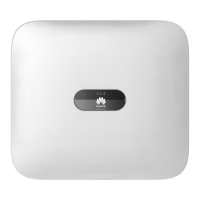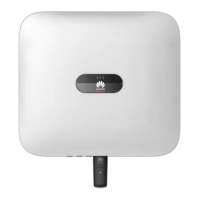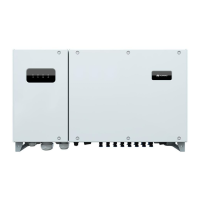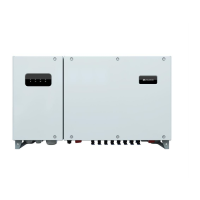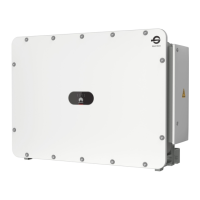What to do if Huawei SUN2000-3KTL-L1 shows AFCI Check Failure?
- Ccindy72Aug 30, 2025
If your Huawei Inverter displays an AFCI Check Failure, turn off the AC output switch and DC input switch, and then turn them on after 5 minutes.

What to do if Huawei SUN2000-3KTL-L1 shows AFCI Check Failure?
If your Huawei Inverter displays an AFCI Check Failure, turn off the AC output switch and DC input switch, and then turn them on after 5 minutes.
What causes a DC Arc Fault in a Huawei SUN2000-3KTL-L1?
A DC Arc Fault in your Huawei Inverter can be caused by arcing or poor contact in the PV string power cables. Check whether the string cables arc or are in poor contact.
What to do if my Huawei Inverter shows Low Insulation Resistance?
If your Huawei Inverter shows a Low Insulation Resistance error, it indicates a short circuit between the PV array and the ground, or that the ambient air of the PV array is damp, causing poor insulation. First, check the output impedance of the PV array to ground. If there is a short circuit or lack of insulation, rectify it. Second, check that the PE cable of the SUN2000 is correctly connected. Third, if the impedance is lower than the specified protection threshold in rainy and cloudy days, set Insulation resistance protection using the mobile app, SmartLogger, or NMS.
What does Grid Underfrequency mean for Huawei Inverter?
If your Huawei Inverter shows a 'Grid Underfrequency' error, the power grid frequency is too low. Here's how to address it: 1. If the alarm occurs occasionally, the power grid may be temporarily abnormal. The SUN2000 will automatically recover when the grid returns to normal. 2. If it happens frequently, check if the grid frequency is within the allowed range. If not, contact your local power operator. If it is, modify the grid underfrequency protection threshold via the mobile app, SmartLogger, or NMS with the power operator's consent.
How to fix String Reversed error on Huawei SUN2000-3KTL-L1?
If your Huawei SUN2000 Inverter shows a String Reversed error, it means the PV string is reversely connected. To resolve this, check if the PV string is reversely connected to the SUN2000. If it is, wait until the PV string current decreases below 0.5 A, set the DC switch to OFF, and adjust the PV string polarity.
What to do if my Huawei SUN2000-3KTL-L1 has a Device Fault?
If your Huawei SUN2000 Inverter has a Device Fault, turn off the AC output switch and DC input switch, and then turn them on after 5 minutes.
How to cool down my Huawei SUN2000-3KTL-L1?
If your Huawei Inverter is overheating, it's likely installed in a poorly ventilated area, the ambient temperature is too high, or the device isn't working correctly. Check the ventilation and ambient temperature around the installation location.
How to fix Upgrade Failed on Huawei SUN2000-3KTL-L1 Inverter?
If the Huawei Inverter displays 'Upgrade Failed or Version Mismatch', it means the upgrade did not complete normally. Try performing the upgrade again. If it fails multiple times, contact your dealer or Huawei technical support.
What to do if my Huawei SUN2000-3KTL-L1 showing Overtemperature?
If your Huawei Inverter is showing an Overtemperature warning, it indicates that the unit is installed in a location with poor ventilation, the ambient temperature is too high, or the SUN2000 is not working properly. You should check the ventilation and ambient temperature of the SUN2000 installation position. If the ventilation is poor or the ambient temperature exceeds the upper threshold, improve the ventilation and heat dissipation.
What to do if Huawei SUN2000-3KTL-L1 Inverter displays DC Arc Fault?
If your Huawei Inverter displays a DC Arc Fault, it means the PV string power cables are arcing or have poor contact. You should check whether the string cables arc or are in poor contact.
| Max. efficiency | 98.4% |
|---|---|
| Max. input voltage | 600 V |
| Nominal output power | 3000 W |
| Dimensions (W x H x D) | 365 x 365 x 156 mm |
| Operating temperature range | -25°C to +60°C |
| Nominal AC voltage | 220 V / 230 V / 240 V |
| MPPT voltage range | 90 V - 560 V |
| Rated input voltage | 360 V |
| Number of MPPTs | 2 |
| Cooling | Natural Convection |
| Protection degree | IP65 |
| Rated output voltage | 220 V / 230 V / 240 V |
| Output frequency | 50 Hz / 60 Hz |
| Power factor | 0.8 leading ... 0.8 lagging |
| THDi | <3% |
| Efficiency | 98.4% |
| Warranty | 10 years |
| Max. apparent AC power | 3300 VA |
| Max. output power | 3300 W |
Safety precautions related to personal injury, electric shock, and fire.
Safety precautions related to electrical hazards and grounding.
Guidelines for selecting the optimal installation location.
Detailed steps for wall-mounting the SUN2000.
Detailed steps for support-mounting the SUN2000.
Essential safety precautions before making electrical connections.
Instructions for preparing various types of cables for connection.
Procedure for connecting PE (ground) cables.
Steps for connecting the AC output power cable.
Procedure for connecting DC input power cables.
Steps for connecting battery cables.
Checklists for verifying the system before powering on.
Steps and prerequisites for powering on the SUN2000 system.
Steps for commissioning the system using the FusionSolar App.
Guide to setting various system parameters.
Controls for managing power output and energy flow.
Settings for controlling power output at the grid connection point.
Controls for managing apparent power output.
Settings for controlling battery charging and discharging.
Steps to safely power off the SUN2000 system.
Schedule and procedures for routine system maintenance.
Common alarms and their troubleshooting measures.
Detailed technical specifications for the SUN2000 models.
Procedure to identify and locate insulation resistance faults.
